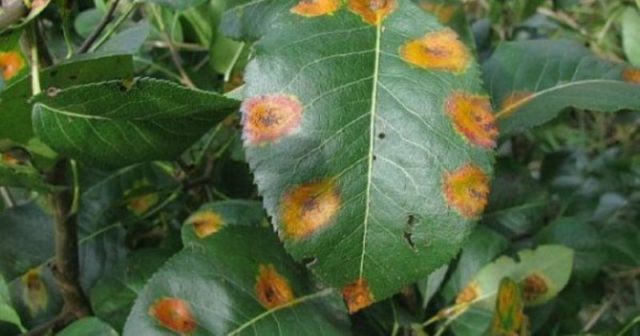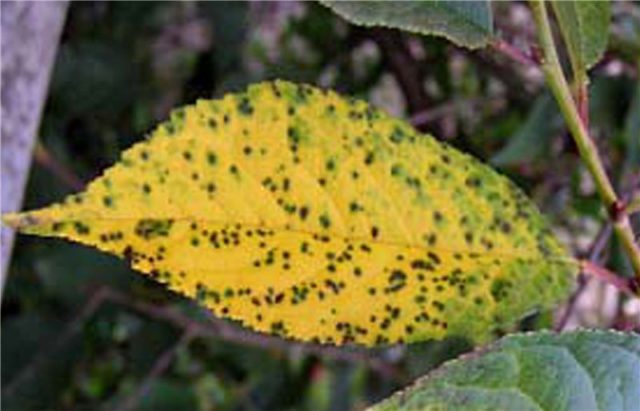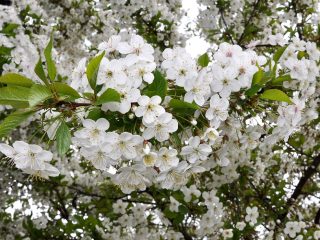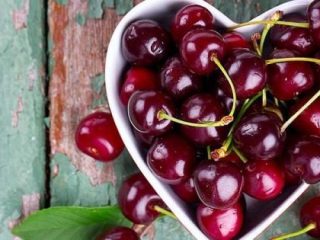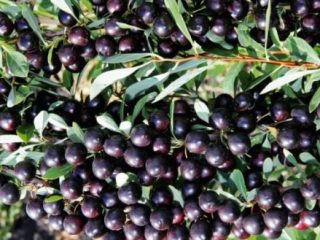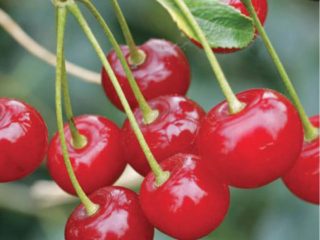Content
Almost every gardener grows cherries in their summer cottage. But to get a rich harvest, it is important to choose the right variety. It must be adapted to climatic conditions, be highly productive and have immunity to many diseases. Igritskaya cherry is suitable for cultivation in all regions of Russia, since the variety is unpretentious, frost-resistant, rarely susceptible to fungal diseases and has positive qualities.
Description of Igritskaya cherry
Igritskaya cherry is a relatively young variety. The short-trunked tree with spreading branches was bred by Russian scientists at the Lupine Research Institute. The variety gained great popularity among gardeners in 2004. It is especially valued in regions with an unstable climate and cold winters.
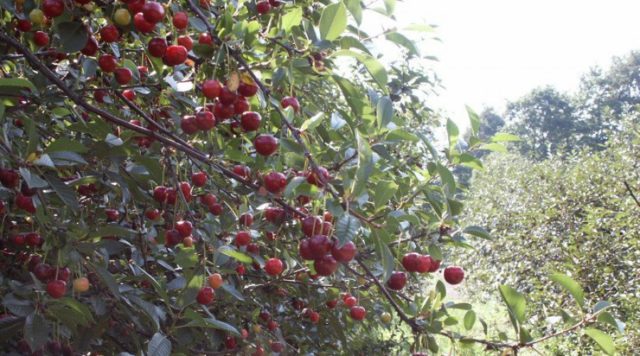
Spreading tree, small in size
Height and dimensions of an adult tree
The Igritskaya cherry variety forms a low tree about 2 meters high. In spring, the crown is covered with dark emerald, oblong leaves and snow-white flowers with a pleasant aroma.
Description of fruits
In the fifth year after planting, medium-sized semicircular fruits appear on the tree. Juicy, dense, dark red flesh is covered with a rich red skin. The small, oval bone is easily separated from the sweet and sour pulp.
Pollinators for Igritskaya cherries
Igritskaya cherry is a partially self-fertile variety, but without pollinating varieties, about 50% of the berries are set on the tree. But in order to collect the maximum harvest from a tree, experienced gardeners recommend planting varieties such as Zhuravka, Vladimirskaya, Zhukovskaya, Lyubskaya nearby.
Main characteristics
Igritskaya cherry is an unpretentious, late-ripening variety. Before buying a cherry seedling of the Igritskaya variety, you need to look at the photo, know the description and all the positive and negative sides.
Drought resistance, frost resistance
Igritskaya cherry is frost-resistant; without shelter it can withstand frosts down to -30 °C, so the variety is often planted in regions with an unstable climate. But in order to preserve a young planted seedling and grow it into a small, spreading tree, in the first years winter cover with peat, humus or rotted compost is required.
The root system of cherries is superficial, so in dry summers regular and abundant watering is necessary. An adult tree spends at least 10 times water. Cherries will also like rain irrigation, which is carried out in the morning or evening.
Productivity
Igritskaya cherry is a high-yielding variety.Subject to agrotechnical rules, an adult tree can produce 8 buckets of tastier, healthier berries in the 5th year after planting. Productivity depends on the growing region, care rules and the presence of pollinator varieties.
The harvested crop is suitable for making compotes and jam. But before cooking, you must remember that the seed contains toxic substances, so before canning, the berries are washed and the pulp is separated from the seed. The berries can also be frozen and dried. The dried harvest is perfect for making tea and medicinal infusions.
Dried berries are stored in cloth or paper bags in a dark, dry place. Shelf life is no more than 1 year.
Due to their thick skin, Igritskaya cherries tolerate long-term transportation well and retain their taste and aroma for a long time.
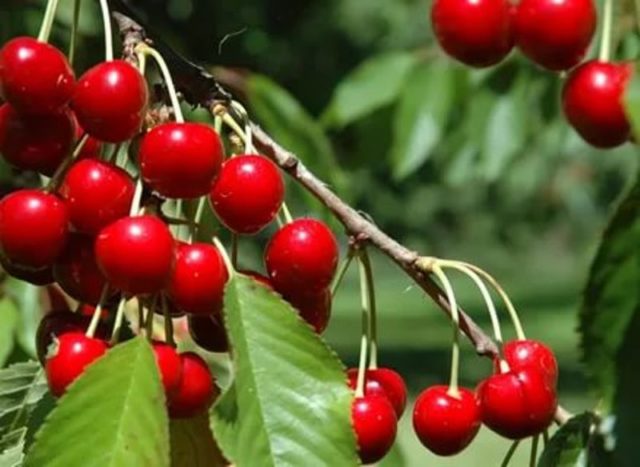
Ripe berries have a sweet and sour taste
Advantages and disadvantages
The Igritskaya cherry variety has positive and negative qualities. The advantages of many gardeners include the following:
- high productivity;
- immunity to fungal diseases;
- dessert taste and versatility in use;
- ease of care;
- self-fertile;
- frost resistance.
Disadvantages include late fruiting.
Planting and caring for Igritskaya cherries
The Igritskaya cherry variety is an unpretentious tree, so it can be grown both in warm areas and in regions with an unstable climate. But to get a rich harvest, it is important to follow agrotechnical rules, choose the right place for planting and know the diseases and pests of cherries.
Recommended timing
Cherry seedlings can be planted in spring and autumn.Spring planting is recommended for the northern regions, since during the summer the tree will be able to build up a full-fledged root system and go into winter stronger. In autumn they are planted a month before the onset of cold weather. After planting, the tree trunk circle is generously watered and mulched.
Site selection and soil preparation
The health of the fruit crop, growth, development and productivity depend on the right location. Cherry is a light-loving crop, so the planting area should be located in the sun. In order for the tree to quickly settle into a new place, it is important to follow simple rules:
- The distance between seedlings is at least 3 m.
- Plant the seedling only on the south side.
- The location of groundwater is 1.5-2 m.
- The soil should be loamy or sandy loam.

The distance between landings should not be less than 3 meters
How to plant correctly
Planting a cherry seedling is not a difficult job, but in order for it to grow and develop well, you need to listen to the advice of experienced gardeners. Planting a young tree:
- The seedling is carefully examined. The roots should be free of damage and no sign of disease. The bark is evenly colored, without cracks or signs of rot. Before planting, skeletal branches are shortened.
- Dig a hole measuring 50x60 cm. The bottom is covered with drainage made of broken bricks, pebbles or expanded clay. The excavated soil is mixed with humus, potassium chloride and superphosphate.
- The roots of the seedling are straightened and placed in the center. The voids are filled with a nutrient mixture.
- The top layer is compacted, shed generously and mulch.
Features of care
Despite its unpretentiousness, Igritskaya cherry requires proper care for high fruiting.After each watering, the soil is loosened and weeds are removed. In spring and autumn, carry out sanitary and formative pruning.
For good growth and development, the acidified soil is mixed with lime or dolomite flour every 5 years. To protect plantings from pests and diseases, preventive spraying is carried out with Bordeaux mixture or copper sulfate.
Watering and fertilizing schedule
Igritskaya cherry is a drought-resistant variety. Watering is carried out only after the top layer of soil has dried out. An adult crop is watered 4 times a season:
- after flowering;
- during the period of active growth of ovaries;
- after harvest;
- a month before the onset of frost.
Irrigation should be plentiful; about 1 bucket of water is spent on an adult tree. In autumn, the volume is doubled.
Fertilizing is needed for abundant fruiting. The first replenishment is carried out 2 years after planting. Rotted compost and ammonium nitrate are applied in the spring. Potassium chloride, superphosphate or wood ash - in the fall. Fertilizer is applied strictly according to the instructions on well-moistened soil.
Trimming
Pruning is an important stage in caring for Igritskaya cherries. It will allow you to form a beautiful crown, get rid of dry and damaged shoots, and increase productivity.
The first pruning is done 1-2 years after planting. Side branches are shortened, inward and vertically growing branches are removed. The procedure is carried out in the spring, before buds open, or in the fall after leaf fall. Summer pruning is carried out only when necessary, removing damaged or diseased shoots.

Pruning is carried out in spring and autumn
Preparing for winter
Igritskaya cherry is a winter-hardy variety.But in order for a young seedling to survive wintering well, it needs to be prepared:
- The tree trunk circle is dug up, shed abundantly, and mulch.
- The tree is fed with phosphorus-potassium fertilizers.
- The trunk is covered with a solution of lime, copper sulfate and PVA glue.
- After the first frost, the crown is sprayed with a 5% urea solution.
- The seedling is covered with non-woven breathable material.
- To protect against rodents, a metal frame is installed.
Diseases and pests
Igritskaya cherry has strong immunity to diseases and pests. But if the rules of care are not followed, the following may appear on the tree:
- Rust - numerous rust-colored spots appear on the leaf plate. Without treatment, the leaves fall off, the tree stops developing and goes into winter weakened. The next year there is no fruiting. You can help the tree by spraying it with copper oxychloride before flowering and after harvesting with Bordeaux mixture. All fallen leaves are collected and burned.
The fungus manifests itself in the first half of summer
- Coccomycosis is a fungal disease that affects foliage and fruits. Infection occurs before flowering. The foliage becomes covered with pale or bright red spots, and over time it turns yellow and falls off. To combat the fungus, the tree is treated with 1% Bordeaux mixture.
A dangerous disease that leads to the death of the plant
- Moniliosis - the disease appears after flowering. The bark becomes covered with a gray growth, the fruits rot, the branches crack, releasing gum. Treatment consists of treatment with broad-spectrum fungicides.
Without treatment, productivity decreases
- Aphids are insects that appear in early spring. Pests settle in large colonies, suck out the sap, the tree weakens, lags behind in growth and development.Control is carried out with insecticides at a temperature not lower than + 5 °C.
Pests settle on the inside of the leaf
Conclusion
Igritskaya cherry is an ideal variety for growing in regions with cold, long winters. If you follow the rules of care and preventive measures, the tree will delight you with a bountiful harvest. Due to its sweet and sour taste, the berry is suitable for preparing preserves for the winter.
